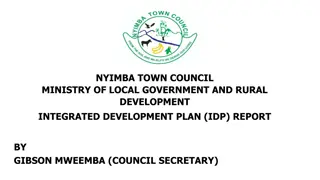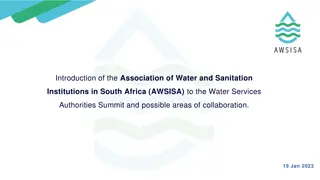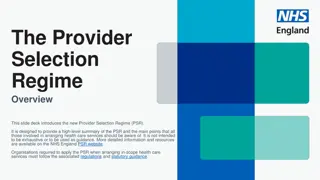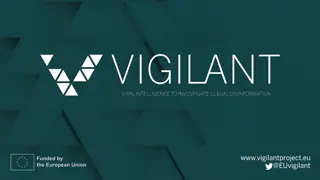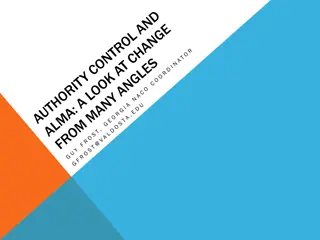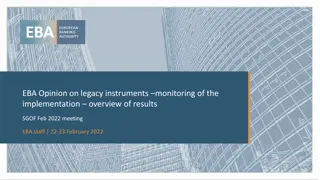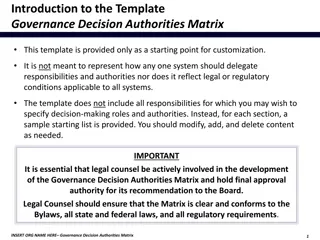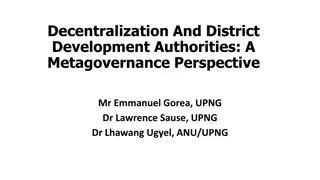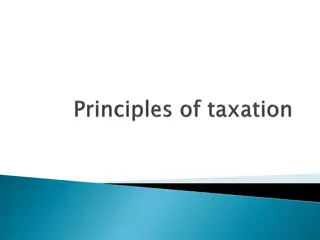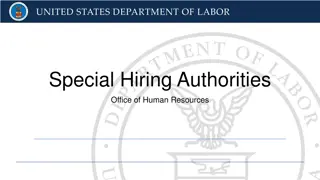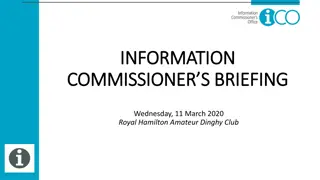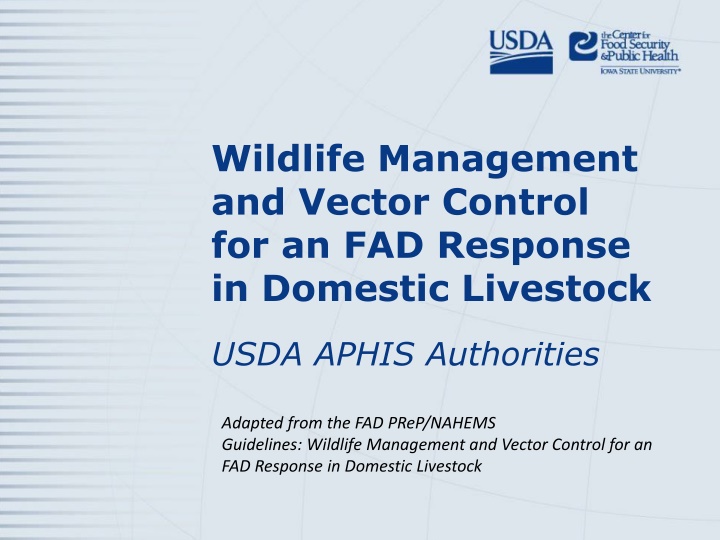
Wildlife Management and Vector Control for FAD Response in Livestock
This presentation discusses the roles, responsibilities, and authorities involved in wildlife management and vector control for responding to Foreign Animal Disease (FAD) outbreaks in domestic livestock. It covers definitions, laws, regulations, and collaboration between USDA APHIS and other relevant authorities during FAD incidents involving wildlife. The focus is on the actions required to prevent, detect, and control FAD outbreaks effectively.
Download Presentation

Please find below an Image/Link to download the presentation.
The content on the website is provided AS IS for your information and personal use only. It may not be sold, licensed, or shared on other websites without obtaining consent from the author. If you encounter any issues during the download, it is possible that the publisher has removed the file from their server.
You are allowed to download the files provided on this website for personal or commercial use, subject to the condition that they are used lawfully. All files are the property of their respective owners.
The content on the website is provided AS IS for your information and personal use only. It may not be sold, licensed, or shared on other websites without obtaining consent from the author.
E N D
Presentation Transcript
Wildlife Management and Vector Control for an FAD Response in Domestic Livestock USDA APHIS Authorities Adapted from the FAD PReP/NAHEMS Guidelines: Wildlife Management and Vector Control for an FAD Response in Domestic Livestock
This Presentation Definitions Laws, regulations Relevance of wildlife Roles and responsibilities of authorities during an FAD response 2 FAD PReP/NAHEMS Guidelines: Wildlife, Vector Control - Authorities USDA APHIS and CFSPH
Definitions Wild animal: (OIE) an animal that has a phenotype unaffected by human selection and lives independent of direct human supervision or control Wildlife: (APHIS) all free-ranging animals, including native and exotic wildlife species, as well as feral domestic animals 3 FAD PReP/NAHEMS Guidelines: Wildlife, Vector Control - Authorities USDA APHIS and CFSPH
Definitions contd Feral: domestic animals not confined Wildlife reservoir: free-ranging species living as a potential source of infection/infestation Vector: any living organism that can carry disease agents Biological transmission: disease agent transfer from host to susceptible animal Mechanical transmission: disease agent transfer from host to susceptible animal via external body parts 4 FAD PReP/NAHEMS Guidelines: Wildlife, Vector Control - Authorities USDA APHIS and CFSPH
USDA APHIS Authorities for Responding to an FAD Outbreak in Domestic Livestock
FAD and Emerging Diseases FAD: animal disease or pest not known to exist in US or territories Emerging disease: change or mutation in pathogenicity, communicability or zoonotic potential to become a threat When livestock outbreak involves wildlife - USDA APHIS and authorities with jurisdiction over wildlife collaborate 6 FAD PReP/NAHEMS Guidelines: Wildlife, Vector Control - Authorities USDA APHIS and CFSPH
Animal Health Protection Act APHIS authority through AHPA Act Enables Secretary of Agriculture to: Prevent, detect, control, eradicate diseases and pests To protect health/welfare, economic interests, environment and commerce Prohibit or restrict importation, entry, interstate movement Cooperate with agencies to control animal diseases 7 FAD PReP/NAHEMS Guidelines: Wildlife, Vector Control - Authorities USDA APHIS and CFSPH
Code of Federal Regulations 9 CFR 71.2: Issue rule governing quarantine, movement of diseased animals, poultry 9 CFR 71.3: Prohibited movement of diseased animals and poultry 9 CFR 53: Certain communicable diseases of livestock or poultry 9 CFR 161: Standards for AVs and revocation of accreditation 8 FAD PReP/NAHEMS Guidelines: Wildlife, Vector Control - Authorities USDA APHIS and CFSPH
Guidance for Veterinary Services VS Memorandum 573.1 - USDA, APHIS, VS Animal Health Policy in Relation to Wildlife Work with wildlife entities with primary authority and responsibility Support disease eradication Movement, testing requirements Herd plans Emergency response plans to keep wildlife and livestock apart 9 FAD PReP/NAHEMS Guidelines: Wildlife, Vector Control - Authorities USDA APHIS and CFSPH
Guidance for VS contd State fish and wildlife agencies have primary authority and responsibility VS may implement actions under certain conditions Secretary of Ag will consult with State authorities Collaborative relationships 10 FAD PReP/NAHEMS Guidelines: Wildlife, Vector Control - Authorities USDA APHIS and CFSPH
Relevance of Wildlife in an FAD Outbreak in Domestic Livestock or Poultry
Epidemiological Factors Interactions between host, agent, environment Agent: range, resistance, affinity, dose, mode of transmission Host: species, age, immune/nutritional status Environment: housing, care, weather, vector presence 12 FAD PReP/NAHEMS Guidelines: Wildlife, Vector Control - Authorities USDA APHIS and CFSPH
Epidemiological Factors contd Immediately assess wildlife during an FAD Detect cases Understand disease characteristics Identify disease risks Provide information for control Evaluate effectiveness of control and adjust 13 FAD PReP/NAHEMS Guidelines: Wildlife, Vector Control - Authorities USDA APHIS and CFSPH
Species Susceptibility 14 FAD PReP/NAHEMS Guidelines: Wildlife, Vector Control - Authorities USDA APHIS and CFSPH
Species Susceptibility contd 15 FAD PReP/NAHEMS Guidelines: Wildlife, Vector Control - Authorities USDA APHIS and CFSPH
Ecological Factors of Wildlife 16 FAD PReP/NAHEMS Guidelines: Wildlife, Vector Control - Authorities USDA APHIS and CFSPH
Ecological Factors of Wildlife contd 17 FAD PReP/NAHEMS Guidelines: Wildlife, Vector Control - Authorities USDA APHIS and CFSPH
International Trade OIE distinguishes between wildlife infection and domestic infection for some diseases wildlife role in transmission, maintenance of agent Not all countries will follow OIE guidelines for trade 18 FAD PReP/NAHEMS Guidelines: Wildlife, Vector Control - Authorities USDA APHIS and CFSPH
International Trade contd Affected wildlife may not always mean domestic livestock are affected FAD existence in wildlife may make disease-freedom difficult Trade may be affected with FAD presence in exporting country 19 FAD PReP/NAHEMS Guidelines: Wildlife, Vector Control - Authorities USDA APHIS and CFSPH
FAD Detection for Disease Agents For example 20 FAD PReP/NAHEMS Guidelines: Wildlife, Vector Control - Authorities USDA APHIS and CFSPH
Roles and Responsibilities in an FAD Outbreak
ICS, NIMS, Unified Command Critical to controlling an outbreak Wildlife Cell, Vector Control Group Wildlife and disease management expertise Planning, Operation Sections Coordinate activities Conducted with appropriate agencies Conducted by skilled personnel 22 FAD PReP/NAHEMS Guidelines: Wildlife, Vector Control - Authorities USDA APHIS and CFSPH
Wildlife and Vector Control Personnel Team will vary depending on incident Personnel need wildlife-related experience Assessing presence of wildlife Assessing potential for disease spread Determining wildlife infection Wildlife surveillance measures Wildlife disease control Implementing prevention measures 23 FAD PReP/NAHEMS Guidelines: Wildlife, Vector Control - Authorities USDA APHIS and CFSPH
Role of APHIS Wildlife Services Coordinate with Federal, State partners SERS, NWDP Primary emergency response contact Group of biologists ready for mobilization in 24-48 hours Receive training, medical clearance, PPE, training drills SERS - Surveillance and Emergency Response System NWDP - National Wildlife Disease Program 24 FAD PReP/NAHEMS Guidelines: Wildlife, Vector Control - Authorities USDA APHIS and CFSPH
Role of Livestock Owners/Producers Prevent the introduction of diseases into domestic livestock Prevent the spread of disease to wildlife Fencing barrier create a buffer Wire netting, sealed entry points prevent direct contact 25 FAD PReP/NAHEMS Guidelines: Wildlife, Vector Control - Authorities USDA APHIS and CFSPH
Resources for Livestock Owners/Producers Biosecurity for the Birds http://healthybirds.aphis.usda.gov Center for Food Security and Public Health (CFSPH) disease factsheets http://www.cfsph.iastate.edu FAD PReP/NAHEMS Guidelines: Biosecurity http://www.aphis.usda.gov/fadprep USDA APHIS Wildlife Services http://www.aphis.usda.gov/ wildlife_damage/index.shtml 26 FAD PReP/NAHEMS Guidelines: Wildlife, Vector Control - Authorities USDA APHIS and CFSPH
For More Information FAD PReP/NAHEMS Guidelines: Wildlife Management and Vector Control for an FAD Response in Domestic Livestock http://www.aphis.usda.gov/fadprep Wildlife Management and Vector Control web-based training module Coming soon 27 FAD PReP/NAHEMS Guidelines: Wildlife, Vector Control - Authorities USDA APHIS and CFSPH
Guidelines Content Authors (CFSPH) Glenda Dvorak, DVM, MS, MPH, DACVPM Nicole Seda, BS Meghan Blankenship, BS Heather Allen, PhD, MPA Contributor (USDA) Jonathan Zack, DVM 28 FAD PReP/NAHEMS Guidelines: Wildlife, Vector Control - Authorities USDA APHIS and CFSPH
Guidelines Content Reviewers (USDA) Randall Levings, DVM, MS Randall Crom, DVM Michael Messenger, PhD Michael David MS, VMD, MPH Wildlife Disease Steering Committee Subject Matter Experts Claudio L. Afonso Samantha Gibbs, DVM, PhD D. Scott McVey, DVM, PhD, DACVM David Suarez, DVM 29 FAD PReP/NAHEMS Guidelines: Wildlife, Vector Control - Authorities USDA APHIS and CFSPH
Acknowledgments Development of this presentation was by the Center for Food Security and Public Health at Iowa State University through funding from the USDA APHIS Veterinary Services PPT Authors: Abbey Smith, Student Intern; Janice Mogan, DVM Reviewers: Glenda Dvorak, DVM, MPH, DACVPM; Heather Allen, PhD, MPA




